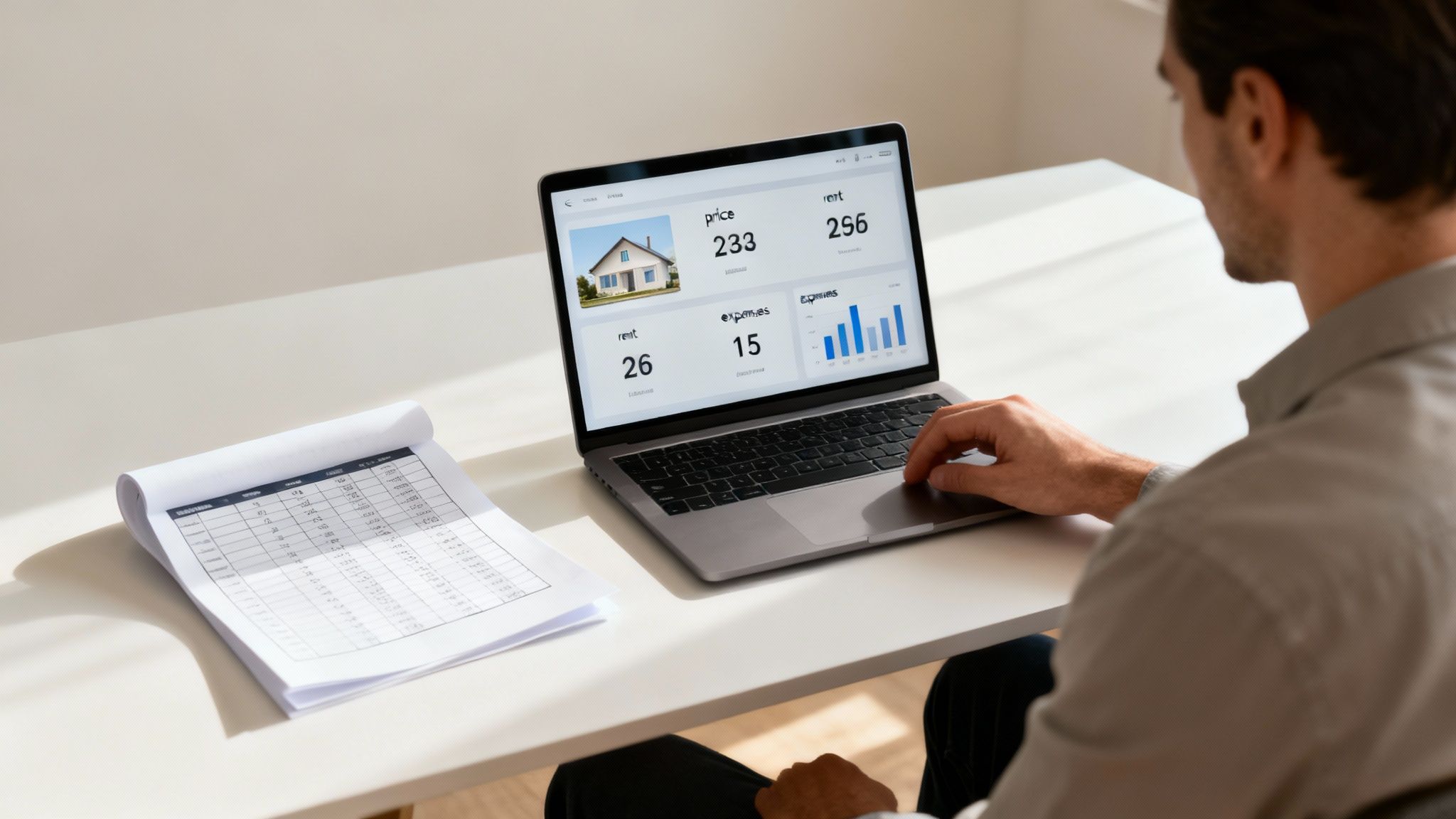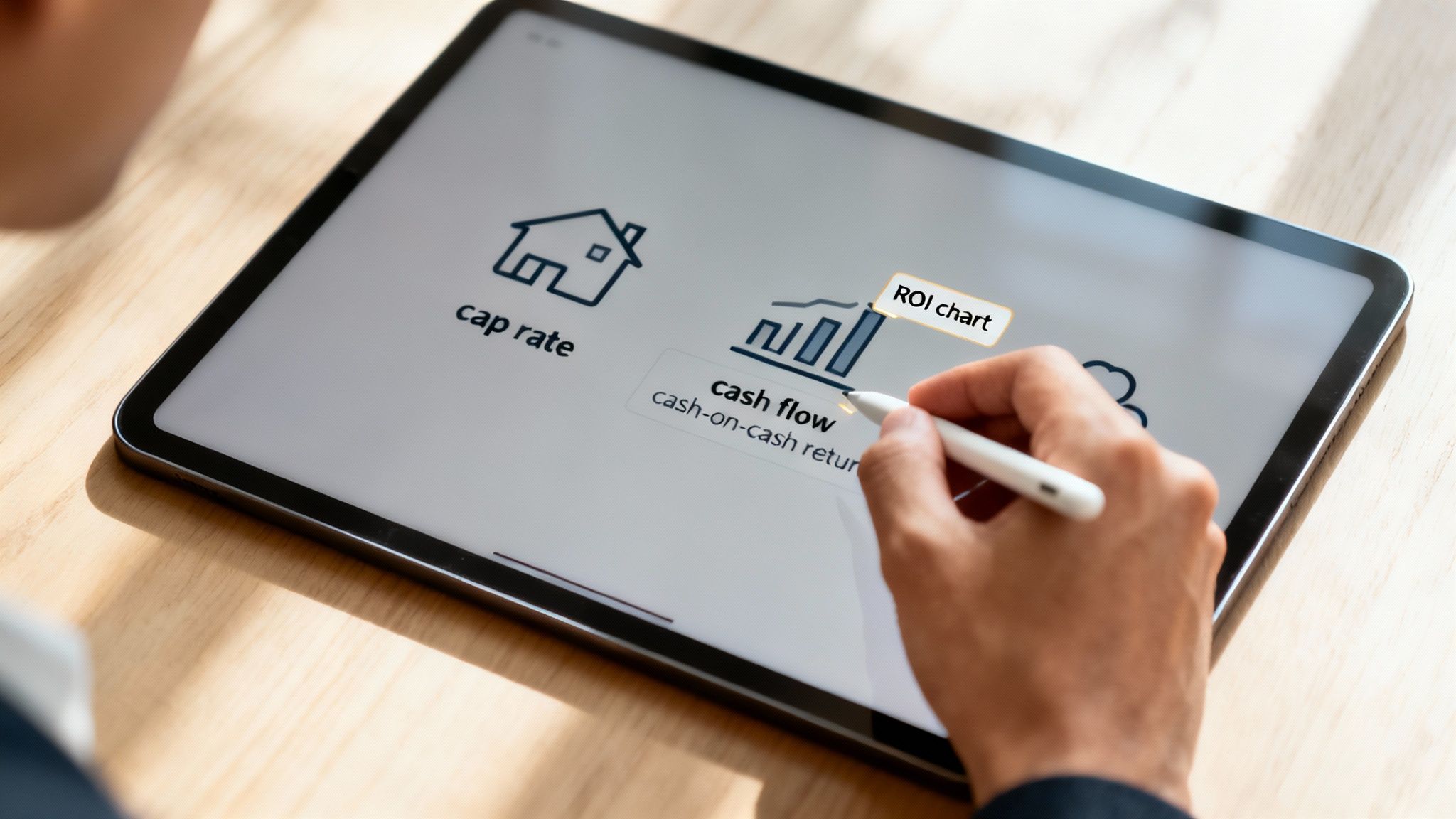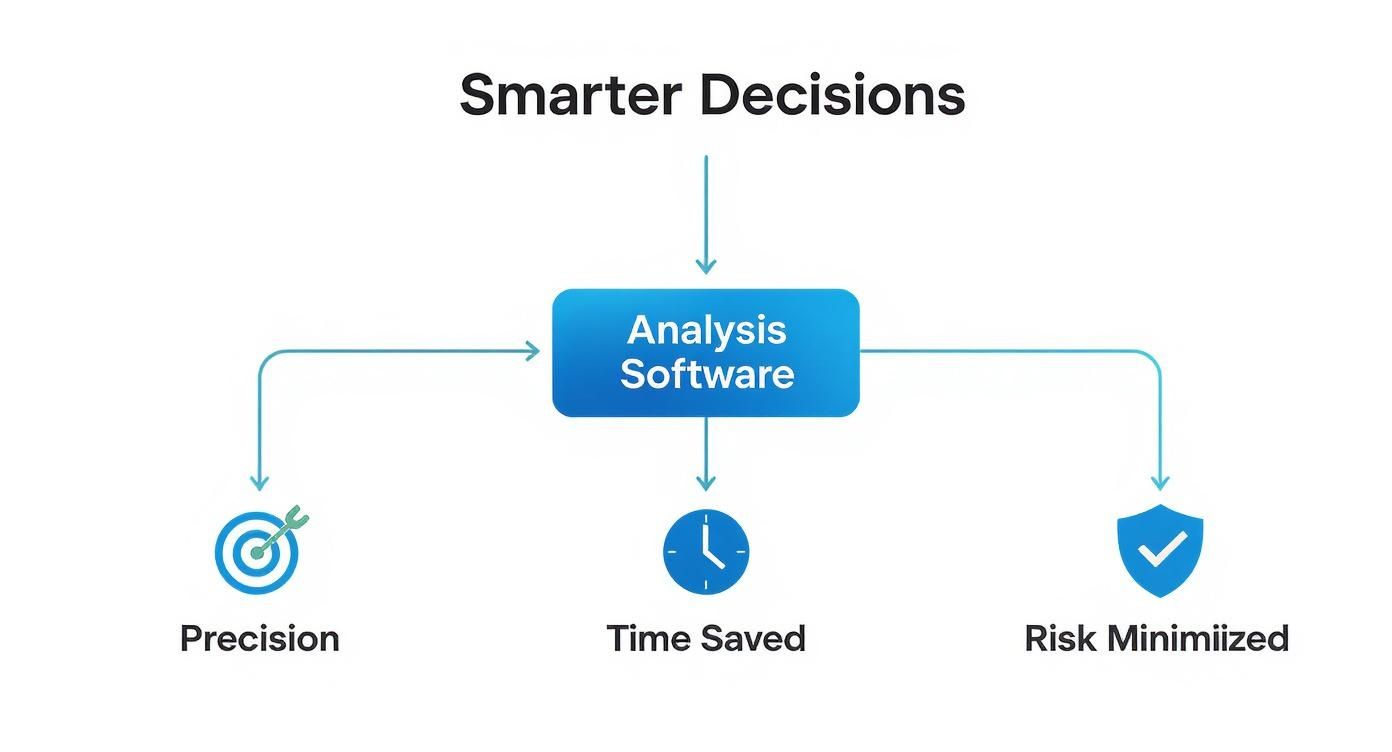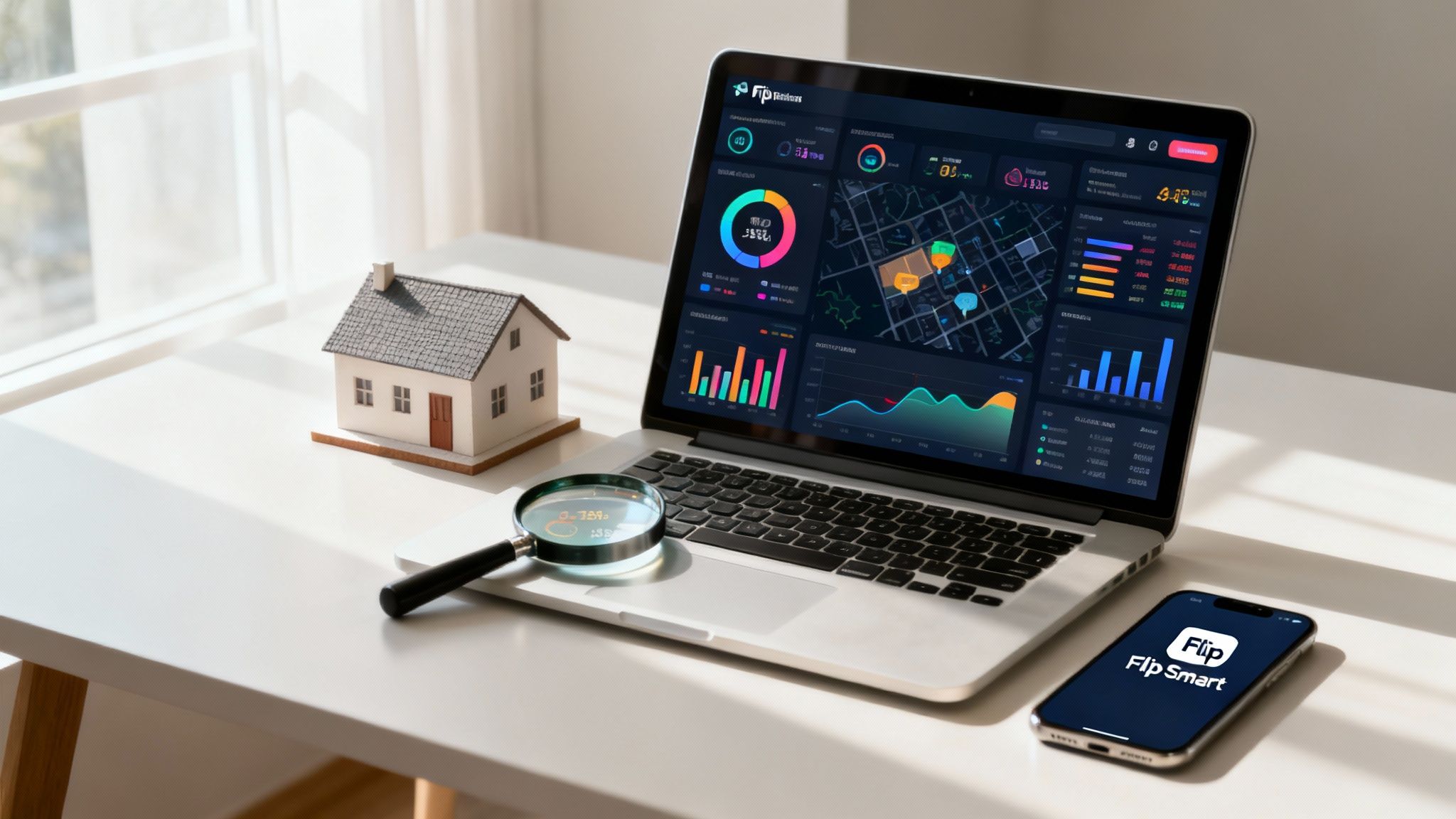Buying a home is one of the biggest financial decisions you'll ever make. With so much on the line, how can you be sure a property is a good investment? Real estate analysis software is a specialized tool that helps you answer that question by replacing guesswork with data. Instead of relying on gut feelings, it pulls together market data, property details, and financial metrics to give you a clear, data-driven picture of a home's value and potential.
What Is Real Estate Analysis Software?
Imagine you're trying to figure out if a house is a good deal. You could spend hours searching online for similar homes that have recently sold, trying to estimate potential repair costs, and building complicated spreadsheets to calculate your monthly payment. It's a lot of work, and one small mistake could lead to a big financial headache.
Real estate analysis software simplifies this entire process. Think of it as a powerful financial calculator designed specifically for property. It takes all the important details—like the purchase price, your down payment, estimated taxes, and insurance—and instantly shows you what your investment looks like.

Without it, you’re left wrestling with messy spreadsheets and making educated guesses. That old-school method isn't just slow; it's wide open to human error. A single typo or an overlooked expense can make a seemingly affordable home much more expensive than you thought.
Replacing Guesswork With Data
The biggest problem this software solves is eliminating uncertainty. It helps you trade assumptions for hard, data-backed calculations. This shift allows you to make an offer with confidence, knowing your decision is built on a solid financial foundation.
Here's a quick look at the core tasks these tools handle for you.
Key Functions Of Real Estate Analysis Software
| Function | What It Does | Benefit for Home Buyers |
|---|---|---|
| Calculate Key Metrics | Instantly computes figures like monthly mortgage payment, cash to close, and long-term equity. | See a deal's affordability at a glance without manual math. |
| Project Future Performance | Forecasts a property's costs over time, factoring in taxes, insurance, and maintenance. | Understand the long-term cost of owning a home, not just the purchase price. |
| Estimate Renovation Costs | Provides realistic budgets for repairs or upgrades based on local labor and material costs. | Avoid underestimating your renovation budget and going over what you can afford. |
| Analyze Market Comps | Compares your property to similar recent sales to find an accurate market value. | Determine if the asking price is fair and what the home is truly worth. |
This transition from manual number-crunching to automated insight is a game-changer for modern buyers. If you want to dive deeper into this shift, check out our guide on why smart investors use automated property analysis.
By automating the complex calculations involved in property evaluation, analysis software frees up your most valuable asset: time. Instead of spending hours buried in spreadsheets, you can focus on finding the right home.
Think of this software as your financial co-pilot. It organizes all the mission-critical information into a single dashboard, letting you play with different scenarios. What happens if the purchase price is $10,000 higher? What if your down payment is 5% instead of 10%? You see the impact instantly.
This ability to run scenarios and make calculated moves is what separates a smart home buyer from a gambler. It’s about making a wise investment, not taking a blind risk.
Core Features Every Home Buyer Should Look For
Not all real estate analysis software is created equal. While plenty of platforms can do basic math, the best tools are a whole different beast—they turn raw data into a clear, actionable home-buying strategy.
It's like the difference between a simple calculator and a high-performance financial workstation. Both can add and subtract, but only one gives you the power to make complex, informed decisions that build long-term wealth.
To make sure you're picking a platform that actually helps you, there are several non-negotiable features every buyer should look for. These are the tools that separate confident, data-driven decisions from expensive guesswork.

Dynamic Cash Flow Analysis
For many buyers, especially those considering a property with rental potential (like a duplex or a home with an in-law suite), understanding cash flow is crucial. Cash flow is the money left over each month after all bills are paid. A non-negotiable software feature is a dynamic cash flow calculator that goes way beyond a simple "rent minus mortgage" equation.
A powerful tool lets you plug in and tweak all the real-world expenses you'll face, including:
- Property Taxes: Based on local rates and assessed value.
- Homeowner's Insurance: Estimated annual premiums.
- Vacancy Rate: A percentage to account for periods when a rental unit might be empty.
- Maintenance and Repairs: A fund for leaky faucets, broken appliances, and routine upkeep.
- Property Management Fees: If you plan on hiring someone to manage a rental unit.
Real-World Scenario: You're looking at a duplex that seems like a great deal. The potential rent looks high. But when you use a dynamic cash flow tool to factor in a realistic 7% vacancy rate and set aside 8% for maintenance, the software shows a negative cash flow of $50 per month. That single insight just saved you from buying a property that would have cost you money every month.
Comprehensive ROI Calculations
Your Return on Investment (ROI) is the scorecard that tells you how hard your money is actually working for you. A top-tier real estate analysis platform won’t just spit out one generic ROI number; it will break it down into the key metrics that truly matter.
The most crucial metrics are not just numbers, but stories. They tell you about a property's immediate performance, its long-term potential, and how efficiently it uses your capital to generate wealth.
Look for a tool that instantly calculates:
- Capitalization Rate (Cap Rate): This measures a property's potential return if you paid all cash. It’s a great way to compare different investment properties on an apples-to-apples basis, regardless of financing. It’s calculated by dividing the Net Operating Income (NOI) by the property's market value.
- Cash-on-Cash Return: This is arguably the most important number for rental investors. It tells you the annual pre-tax cash flow you get back relative to the total cash you put into the deal, including your down payment and closing costs.
This hunger for better analytics is driving huge growth in the market. The real estate software industry was valued at $10.24 billion in 2022 and is projected to skyrocket to $25.39 billion by 2030, with cloud-based platforms leading the way. This boom highlights a clear demand for smarter, data-centric tools. You can explore more data on the industry's growth to see how these trends are shaping the future of real estate tech.
Comparative Market Analysis (CMA)
Whether you're buying your first home or an investment property, you absolutely must know what a property is worth. A Comparative Market Analysis (CMA) tool is essential for this. It pulls data on recently sold, similar properties ("comps") in the immediate area to help you nail down an accurate market value.
This feature is critical for making a competitive offer that doesn't overpay. For buyers looking to renovate, it also helps calculate the all-important After Repair Value (ARV).
Real-World Scenario: You find a fixer-upper listed for $250,000. The seller claims it will be worth $400,000 after renovations. But your software's CMA tool crunches the numbers on recent comps and reveals that similar renovated homes in that specific neighborhood are only selling for $320,000. Armed with this hard data, you avoid a massive mistake and can craft a realistic offer based on solid facts.
How Analysis Software Actually Drives Smarter Decisions
Forget the feature lists for a second. The real magic of real estate analysis software is what it does for your bottom line. Bringing this kind of tech into your home-buying process isn't just about making things easier; it’s about fundamentally upgrading the quality of your decision-making.
A good tool gives you three huge advantages that a spreadsheet just can’t touch: surgical precision, your time back, and a serious reduction in financial risk.
Think of it like this: a spreadsheet is a paper map. It shows you the main roads, but that’s it. Analysis software is a live-traffic GPS. It not only maps the route but warns you about potential issues, gives you a real ETA, and finds clever shortcuts you’d never spot on your own.
Achieve Unmatched Precision in Your Numbers
In real estate, a tiny miscalculation can snowball into a massive financial strain. Precision is everything.
Software forces accuracy by using standardized formulas and pulling in real-time data, which sidesteps the human error that always creeps into manual spreadsheets. From local property taxes and insurance rates to maintenance estimates and closing costs, every single variable gets factored in.
This transforms your analysis from a hopeful guess into a reliable financial forecast. You can project a property's total ownership cost with real confidence—not just for year one, but for the next five, ten, or even thirty years.
A relatable story: A first-time home buyer I know, Sarah, was looking at a charming house that seemed perfect. Her spreadsheet model showed an affordable monthly payment. Before making an offer, she plugged the numbers into analysis software. The tool instantly factored in local property taxes and an estimated $200/month for future repairs—two costs she'd underestimated. The software showed the true monthly cost was $350 higher than she thought. That single insight saved her from buying a home that would have stretched her budget to its breaking point.
Reclaim Your Most Valuable Asset: Time
Time is the one thing you can't get more of, and savvy home buyers use it wisely.
Manually analyzing one property—digging for comps, estimating repair costs, and building a budget model—can easily burn hours of your day. With proper real estate analysis software, that entire grind gets compressed into minutes.
Automation is what makes this possible. Instead of juggling a dozen different websites to hunt for data, the software pulls it all into one central dashboard.
- Instant Market Data: Get fresh comparable sales and rental rates without ever leaving the platform.
- Automated Calculations: Every key metric, from your total cash to close to your monthly payment, recalculates instantly as you tweak your numbers.
- Professional Reports: Click a button and generate a clean, shareable report to discuss with your agent, lender, or family.
This isn't just a convenience; it's a massive competitive advantage. It frees you up to analyze more properties, which is how you find the right one for you.
Minimize Risk with Smart Scenario Modeling
Every home purchase has risks. The goal is to take calculated risks, not blind ones. This is where scenario modeling—a core feature of any quality analysis software—becomes your best friend. It lets you stress-test a property against market shifts and nasty surprises before you're financially committed.
You can finally get instant answers to those critical "what-if" questions:
- What if interest rates jump by 1%? See exactly how it impacts your monthly payment and overall affordability.
- What if property taxes are higher than expected? Understand precisely how that affects your monthly budget.
- What if a major repair, like a new roof, is needed in 5 years? Find out if the home is still a good long-term investment.
By modeling these potential outcomes before you even sign a contract, you can build in contingency plans and make offers with a clear-eyed understanding of the true costs. This proactive risk management is what separates smart buyers from those who end up with buyer's remorse, and it’s a hallmark of using professional-grade real estate analysis software.
Choosing The Right Investment Analysis Tool
Stepping into the world of real estate analysis software can feel a lot like walking into a massive hardware store. You know you need a tool to get the job done, but with so many options, are you looking for a simple hammer or a full-power drill set? The truth is, the "best" software isn't about bells and whistles; it's about finding the one that perfectly fits your needs, budget, and how comfortable you are with technology.
The demand for these tools is exploding for a reason. In 2024, the real estate software market hit roughly $9.5 billion, jumping 11.9% from the year before. It's on track to reach $12.6 billion by 2029. This isn't just random growth—it's driven by buyers like you who are tired of guesswork and ready for data-driven decisions.
Your Personal Software Evaluation Checklist
To avoid getting lost in the options, you need a game plan. Think of it like a property inspection—you're methodically checking for strengths, weaknesses, and whether it’s the right fit for you.
Here are the non-negotiables to evaluate before you commit:
- Ease of Use: Is the platform actually intuitive? A tool packed with features is useless if you can’t figure out how to navigate it. Always look for a free trial or a live demo to get a feel for the user experience yourself.
- Essential Features: Does it do what you need it to do? Make sure its core functions align with your goals, whether that’s comparing mortgage options or estimating renovation costs for a fixer-upper.
- Data Accuracy: This is a big one. Where is the data coming from? Trustworthy platforms pull information from reliable sources like the local Multiple Listing Service (MLS) and public records, not just broad national averages.
- Integration Capabilities: Can it play nice with the other tools in your toolbox? While less critical for a home buyer, the ability to easily export data or share reports can be a huge plus.
A good analysis tool helps you make smarter decisions by improving precision, saving time, and cutting down on risk. Each of these paths leads to the same destination: a confident, successful home purchase.

Software Evaluation Checklist
Choosing the right software depends entirely on your specific goals. A first-time home buyer has very different needs from a seasoned investor managing a large portfolio. This table breaks down what to look for based on your experience level.
| Feature/Criteria | First-Time Home Buyer | Experienced Investor | Commercial Investor |
|---|---|---|---|
| User Interface | Simple, guided, and intuitive. Minimal learning curve. | Customizable dashboard, efficient workflows, advanced filters. | Complex data visualization, multi-user access, permissions. |
| Core Analysis | Monthly payment, total cost of ownership, basic ROI calculators. | Multi-scenario analysis, portfolio tracking, sensitivity analysis. | Pro forma statements, NOI, IRR, debt coverage ratios (DSCR). |
| Data Sources | Reliable MLS comps and public record data. | Access to off-market data, historical trends, API access. | Granular demographic data, traffic counts, zoning info. |
| Reporting | Simple, printable PDF reports to share with family or an agent. | Branded, customizable reports with detailed financials. | Institutional-grade reports with advanced financial modeling. |
| Integrations | Not essential, but easy sharing options are a plus. | CRM, accounting software (QuickBooks), and project management tools. | Advanced financial software, lease management platforms. |
Ultimately, the goal is to find a platform that matches your current workflow while offering the room you need to grow. Don't pay for enterprise-level features if you're only analyzing one or two homes.
Pricing Models And Customer Support
Next up, let's talk about the practical side of things. A fantastic tool can quickly become a headache if it’s plagued by hidden fees or non-existent support.
The right software isn't an expense; it's an investment in your own efficiency and accuracy. The cost should be easily offset by the time you save and the costly mistakes you avoid.
Take a hard look at the pricing. Is it a simple monthly fee, or are there different tiers that lock key features behind a paywall? You want transparent pricing so you know exactly what you’re paying for. To see how different platforms stack up, it helps to review lists of the best rental property ROI calculator tools and compare their offerings.
And don't ever underestimate customer support. When you’re stuck on a calculation or a feature isn’t working right, you need help now. Check if they offer a solid knowledge base, video tutorials, or, ideally, live chat support. A company that invests in helping you succeed is one you can trust.
Finding A Tool That Grows With You
Your home-buying journey isn't static. You might start with a starter home today, but in five years, you could be looking for an investment property. The software you pick should be ready for that growth.
This is all about scalability. A scalable tool can handle your needs now and your ambitions for the future, so you aren't forced to migrate all your data to a new system down the line. Look for a platform that can run numbers on a single-family home just as easily as it can analyze an entire rental portfolio. This kind of foresight ensures your software remains an asset, not a liability, for years.
For a deeper look at some of the top platforms on the market, check out our guide on the best real estate investment software.
The Future Of Investing With AI And Predictive Analytics
The world of real estate is getting smarter, and so are the tools we use to make decisions. It's no longer just about calculating today's numbers. The real edge now comes from predicting tomorrow's opportunities with artificial intelligence (AI) and predictive analytics. And no, this isn't some far-off sci-fi concept—it's a powerful advantage you can use right now.
Think of predictive analytics as a weather forecast for the housing market. A basic analysis tells you today's temperature, but a predictive one analyzes massive troves of data—historical sales, demographic shifts, economic trends, even local zoning changes—to tell you what the weather will be next season. This is how savvy buyers spot an opportunity before it shows up on everyone else's radar.

Uncovering Hidden Opportunities With Predictive Models
Traditional analysis is reactive. You see a comparable sale, you react. Predictive analysis is proactive. It lets you get ahead of the curve.
AI-powered software can flag an up-and-coming neighborhood by catching subtle patterns a human might miss, like a small but steady increase in building permits or a slow creep in the average local income.
- Property Appreciation Models: These algorithms can forecast a property's potential value growth with surprising accuracy by weighing dozens of market factors simultaneously.
- Rental Demand Forecasts: By looking at job growth, migration patterns, and existing rental stock, these tools can pinpoint which areas will likely see the highest rental demand in the coming years.
This push towards smarter forecasting is driving huge growth. The commercial real estate software market, valued at $26.36 billion in 2024, is expected to explode to nearly $49.94 billion by 2032. This growth is almost entirely fueled by the demand for AI-powered tools that can manage risk and identify prime assets.
Advanced Data Visualization And Automated Reporting
But all the data in the world is useless if it's just a wall of numbers. That's why the best new software excels at turning complex data into simple, intuitive dashboards. Forget confusing spreadsheets; modern platforms use advanced data visualization to tell a clear story.
You can see heat maps showing which neighborhoods are appreciating fastest, trend lines for rental income, and clean charts that summarize your entire portfolio's performance. For those who want to peek under the hood, understanding the basics of leveraging AI for financial analysis shows just how these complex tasks get automated.
By transforming raw numbers into clear visual insights, AI-powered software doesn't just give you data—it gives you understanding. This clarity is what empowers you to make faster, more confident decisions.
On top of that, automated reporting is a massive time-saver. Imagine creating a professional, data-rich report for your lender or buying partner with a single click. These reports can automatically pull in market forecasts, risk assessments, and financial projections, giving your offer a level of authority that used to be reserved for big institutions.
If you want to see how this works in practice, you can learn more about the role of data analytics in real estate right here on our blog. This blend of foresight and clarity isn't just a feature—it's the future of real estate.
Frequently Asked Questions (FAQ)
What's the most important thing to check before buying a house?
Beyond the physical inspection, the most important thing to check is the financial viability. Use analysis software to run a "stress test." Can you still afford the monthly payment if interest rates go up or if property taxes are higher than estimated? Answering this question with data, not hope, will prevent you from buying a home that strains your budget.
How can I be sure I'm not overpaying for a house?
The best way is to run a Comparative Market Analysis (CMA). Real estate analysis software automates this by pulling data on recently sold, similar homes in the same neighborhood. This gives you a data-backed estimate of the property's true market value, allowing you to make an offer that is fair and competitive without overpaying.
Is this software useful if I'm not a real estate investor?
Absolutely. While investors use these tools for profit analysis, home buyers use them for affordability and long-term cost analysis. It helps you understand the total cost of ownership, including taxes, insurance, and maintenance, not just the mortgage payment. This ensures you buy a home you can comfortably afford for years to come.
Do I still need a real estate agent if I use this software?
Yes. This software is a tool to empower your decision-making, not a replacement for a qualified real estate agent. Your agent provides local expertise, negotiation skills, and guidance through the complex transaction process. The software gives you the financial data; the agent helps you use that data to win the deal.
Ready to stop guessing and start analyzing? Flip Smart gives you the power to evaluate any property in seconds, providing the valuations, renovation costs, and profit potential you need to invest with confidence. Analyze your first deal for free today
